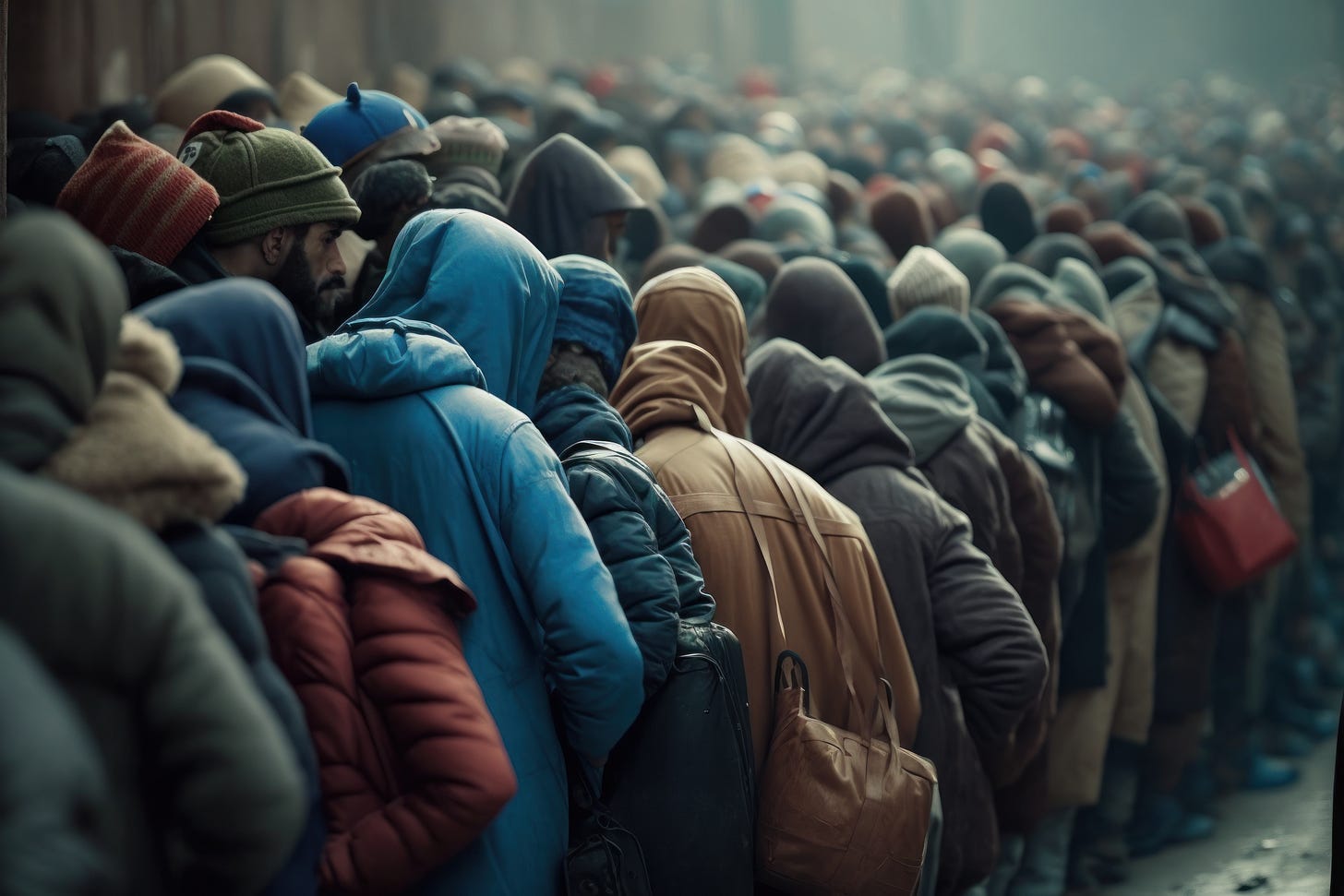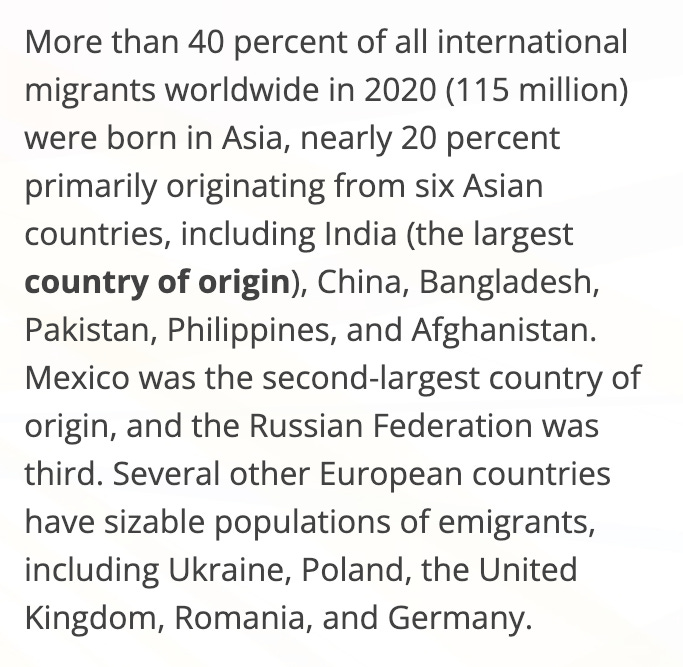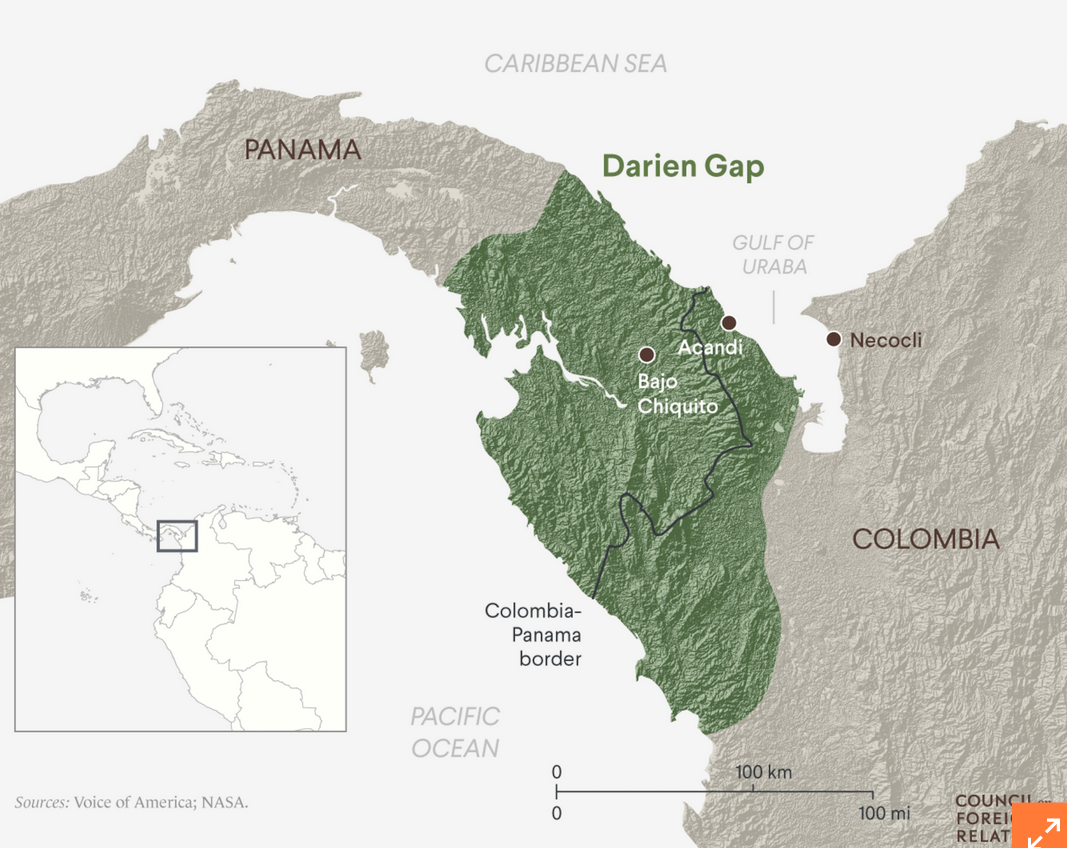The Worldwide Migrant Tidal Wave
Migrants aren't evil. They're in a vice that's called "Move or Die."
We at PolitiSage have been watching the migrant crisis worldwide since the moment we put this newsletter up. We understand that there is a never-ending flood of migrants at the U.S. southern border all the time. The current administration, with its masked ICE agents, is currently targeting brown-skinned people assumed by many to be Mexican. But the worldwide picture is much different.
We republish this post, with additions of the most recent UN information, to provide a backgrounder for PolitiSage’s new subscribers—and to remind those with us for a while that the causes of these problems are neither Democrat nor Republican policies but deep issues of overpopulation starvation, racism, and social terrorism that are locally generated—yet also heavily influenced by worldwide economic disparities, climate change, war (largely always over riches), and gender and color apartheid. What we are facing now is a radical lurch to the right in the United States, Italy, and Great Britain to resist and heavily punish any migrant movement into these wealthy nations and to brutally deport those here, sometimes to foreign prisons where they will be tortured. ICE is rapidly morphing into a secret police force.
Background
It is not, as popularly believed, that Democratic policies are encouraging wave upon wave of migrants to storm the U.S. southern border. It is our all-embracing self-centeredness that makes us believe that whatever goes right—or wrong—must always be a reflection of us. Often it is the case, as has been seen with all major cultures since antiquity, that a great power’s influence runs so deep and broad that it affects almost everything. That is not true in this case. What is happening with migration now—and will happen this year— is largely beyond what Americans do, no matter how we may want to explain away the tragedy or spin fault.
Far to the south of the 60,000 who have languished at the U.S.-Mexican border for months, awaiting the end of the COVID-era Title 42, there are millions of others from Central and South America and the Caribbean who will be on the move this year. Many will head north to the United States on the hope they can escape the life-threatening disintegration of their native countries—which have been subject to three devastating crises.
Crisis #1: The COVID-19 Pandemic
The rampage of COVID-19 through Central and South America was disastrous. Brazil—at sufferance of Bolsonaro’s far-right pandemic denial and anti-vaccine hysteria—had the second-worst infection numbers and death rate in the world. When the pandemic struck Brazil hard, there were hundreds of thousands of migrants from Central America already there, or on their way. There were also ever-growing numbers of Caribbean refugees, mainly Haitians besieged by poverty, a deadly outbreak of cholera, rampant homicide, and terrifying open warfare between criminal gangs. Both groups found a Brazil wracked by disease and ecological disaster. There were no jobs for migrants. And matters were about to get much, much worse.
Crisis #2: The Pandemic Economic Collapse
As in Brazil, there was initial pandemic denial in Mexico and Colombia. Colombia’s president, Iván Duque Márquez, refused to do anything until there were massive pot protests all over the country and people started fleeing the cities for the countryside. In Mexico, President Andrés Manuel López Obrador walked unmasked among frightened peasants, telling them that Jesus wouldn’t allow the pandemic to come to Mexico, so they could all just relax. Want a hug? He refused to cancel a 77,000-fan folk festival in Mexico City—arguably the mother of all super spreader events—even though he knew cases were already proliferating. The press were barred from speaking to hospital staff. Later López Obrador was seen, unmasked, chatting with El Chapo’s 90-something mother through the passenger window of her Rolls Royce.
In both Mexico and Colombia, cases skyrocketed, overwhelming unprepared hospitals and already weak and unstable social welfare systems. Both countries masked and distanced too late, and eventually businesses closed, supply chains broke at their weakest links, and the tourist trade collapsed.
The New York Times observed that the great pandemic recession
hit Latin America harder than almost anywhere else in the world, plunging millions into hunger, destitution and despair. A generation of progress against extreme poverty was wiped out. Unemployment hit a two-decade high. Russia’s invasion of Ukraine choked off a key pipeline for grain and fertilizer, triggering a spike in food prices.
As bad as they were, things were about to get much, much worse.
Crisis #3: Rampant, Widespread Violence
Some countries in Latin America, particularly Mexico and Colombia, have been besieged by drug trafficking and its violence for decades. Colombia has fared better in recent years, but the cartel violence in Mexico never waned. Before the pandemic, some nations—Nicaragua, Guatemala, Honduras, and El Salvador—had significantly recovered from the political wars, some lasting decades, that had plagued them in the 20th century.
But with COVID came new instability. With governments preoccupied with the pandemic and whole populations descending into desperate poverty, drug-related and cartel violence reemerged with lethal fury. Ecuador, with what the International Crisis Group calls its “proximity to major cocaine producers, dollarised economy and corruptible state institutions” is suffering open warfare between drug cartels—and attempts by some cartels to overthrow the government. Costa Rica edges toward civil war. Everywhere in Central America violence has surged from a recent deepening of cartel power and the birth of criminal gangs that prey on the poor.
A Perfect Storm for Displacement
The combination of these three crises left the poor of Latin America in the grip of the most sobering of truths: You will get out, or you will die. Dan Restrepo, Barack Obama’s principal adviser on Latin America, told the New York Times:
“You couldn’t come up with a worse set of facts to leave tens of millions of people with no choice but to move. It’s inevitable that you’d have massive displacement, it really is a perfect storm.”
For several years, the only thing that’s held back a flood of migrants at the southern border has been Title 42, a protocol put in place by the Trump administration to stonewall the millions who are effectively displaced under life-threatening circumstances. Since March 2020, the Border Patrol has invoked Title 42 a staggering 2.7 million times to prevent migrants from entering the United States.
But on May 11th, 2023, by court order, Title 42 lapsed, and fake news, deliberate and merely misinformed, raged over the Internet. There have been more than 96 million views of #titulo42 posts on TikTok. One read: “May 11: You cannot be deported. Title 42 has come to an end.” That was a completely false statement.
More than 400,000 people from South America to attempted the trek through the Darién Gap, the deadly 70-mile stretch of mud-floored jungle that connects Central and South America. The hordes were almost 40 times the size of those that tried it between 2010 through 2020. In 2022, 61% of those crossing the Darién Gap were Haitian.
North of the Darién Gap, migrants from South America were joined by others fleeing poverty and violence in Central America. They will try to move into Mexico, and from there to the United States, but as word spreads of the Trump administration’s draconian violence towards migration, many will be stuck there or decide to try to make it back home. Authorities in Panama and Colombia have tried to close the Darién Gap, but that’s virtually impossible to do.
Post-Title 42 at the Border: Entry into the U.S. Became Harder
If migrants thought the end of Title 42, invoked during COVID, would mean easier access into the United States, they were wrong. Title 42 caused immigration to plunge—but violations carried no legal consequences.
The Biden Plan protocols supported the Trump-threatened DACA people and expanded Temporary Protected Status for at-risk migrants from El Salvador, Honduras, Nicaragua, Somalia, Sudan, Syria, Myanmar, Venezuela and Yemen—and earthquake-ravaged Haiti and Nepal. All of that is gone now.
Donald Trump ran on an anti-immigrant agenda—an agenda that called for the arrest and deportation of millions of people—and that vicious agenda has been effected and prison conditions espoused by Christi Noem, which worsened by the conditions under which people are held, and by the deportations of people to El Salvador. The conditions in prisons in Honduras and The Sudan, with which the US has just struck incarceration agreements, are worse. In allowing the US to follow such protocols, theu US Supreme Court has effectively sanctioned the tortured of people arrested by a masked secret police force without warrant and without probable cause and shipped out of the United States, but not necessarily back to their home countries but to countries running for-profit prisons with the human rights standards for incarceration that are among the lowest on this earth.
The Long Road Ahead
A comprehensive immigration plan can only be drafted and effected by Congress, which is presently thoroughly totally subsumed to Trump’s will. Year after year, decade after decade, the story is always the same: Congress does nothing.
Meanwhile, truly this is a worldwide problem driven by unstable governments and civil wars, regional conflicts, famines, racism, gender apartheid, religious intolerance, and state-sanctioned acts of genocide.
Dan Restrepo is right. The pandemic—and the recession and violence that followed in its wake—created a perfect storm for the displacement of tens of millions of people. U.S. government policy will make the problem easier or more difficult to deal with, but regardless of what this administration or any other does, the only rational conclusion to draw about what will happen next is this:
Until international human rights agreements are strictly adhered to by all nations—and as long as a majority of abiding nations do not sanction those who abuse migrants—the problem will increase. As long as there is an incredibly lopsided problem of wealth between developed countries and the ones that struggle, this problem will continue. As long as there is racism, this problem will continue. As long as there are genocidal wars, this problem will continue. As long as drug gangs target poor families, this problem will continue.
Only evenly applied human rights standards will calm the world’s people and allow them to create peace and abundance in the places where they were born.




Thank you for the clear, understandable explanation about massive migration around the globe. It all boils down to good over evil once again. My heart hurts for the people born into very negative conditions. I also contemplate how it is I, myself, was spared such a life.
Maybe that is the point of The United Nations Islamization. Beginning with Boutros Boutros Ghali a definite legitimacy began to be granted to Jihadism. Perhaps that legitimacy was to allow Jihadist Islamism into Developing Nations to cause massive migrations.